Genealogy can be compared to the trunk of a tree. It sets a foundation for each person as they make their way into the world they live in. Ideally, the tree will have strong roots with a lot of branches to help produce strong and independent fruit. Our tree starts us on the journey of life.
I remember when my kids were in preschool, they started in what the local preschool called, the two day twos. They went to school at age two and a half, for two and a half hours a day, two days a week. Did you catch the theme there?
Even then, with the young mind of a two year old, the study of genealogy presented itself. The teacher printed off a little family tree for each of the students and asked the parents to provide the pictures to fill in the little circles or squares.

The kids might not have fully understood the concept of what they were doing—filling in a family tree—but they could identify who was in the pictures that the parents brought in. The chart or tree that the students helped to create, often with a lot of glue sticks and huge smiles, is a way to engage the child with the members of their family and identify how each one is related to them. The stories that come out of these exercises are an array of hilariously funny to embarrassing for the parents!
This is a crucial place for children to explore their identities, their relationships with not only their parents and siblings but also the world around them. They start to develop special interests and skills as a result of what they are surrounded with. Just as our immediate family is our first folk group, our family is also our first teachers.
As we get older, the study of genealogy evolves with us. Instead of little squares on a piece of paper, we gather more information. Usually, a preschool or early elementary student will only do themselves and possibly their siblings, going back one or two generations in a direct line. The tree will often show both parents and sometimes it will include the grandparents on each side.
When you start a tree, the home person, usually yourself, is number one. Any children that you have would come after or below you—this is called descendants. Your parents would be numbers two and three—this is referred to as ancestors, when we are looking at a tree chart. Genealogy encompasses both!

When we get into the actual tracking and research of a family tree, we include more information like birth dates, death dates, marriages and the dates they occurred. As I noted in the previous post, genealogy focuses on historical dates, locations, and events and that can be verified.
Every year since then, each of my kids have been assigned a similar project. The level of detail and depth of understanding has grown with each of them as they move from one grade to the next. By the second grade, most teachers and schools will include aunts, uncles, and cousins in the family tree. The level of independence goes up and the excitement usually follows!
If you want to engage your kids more or just take another look from a more simplistic view, which I usually do for myself, check out this resource from Greene County, Ohio.
Another great resource if your looking for some engaging ideas.
And as an avid reader, I can’t leave out recommended books. I have not read all of these, but I know there are at least a few gems to find here.
Building your family tree helps you to determine what the relationships actually are. Have you started your tree, yet? I’d love to hear from you. What books or activities have you read or participated in? What can you do this week to dive a bit deeper before we hit up Family History next time?